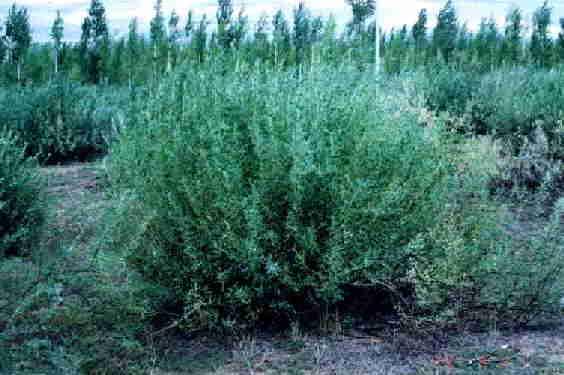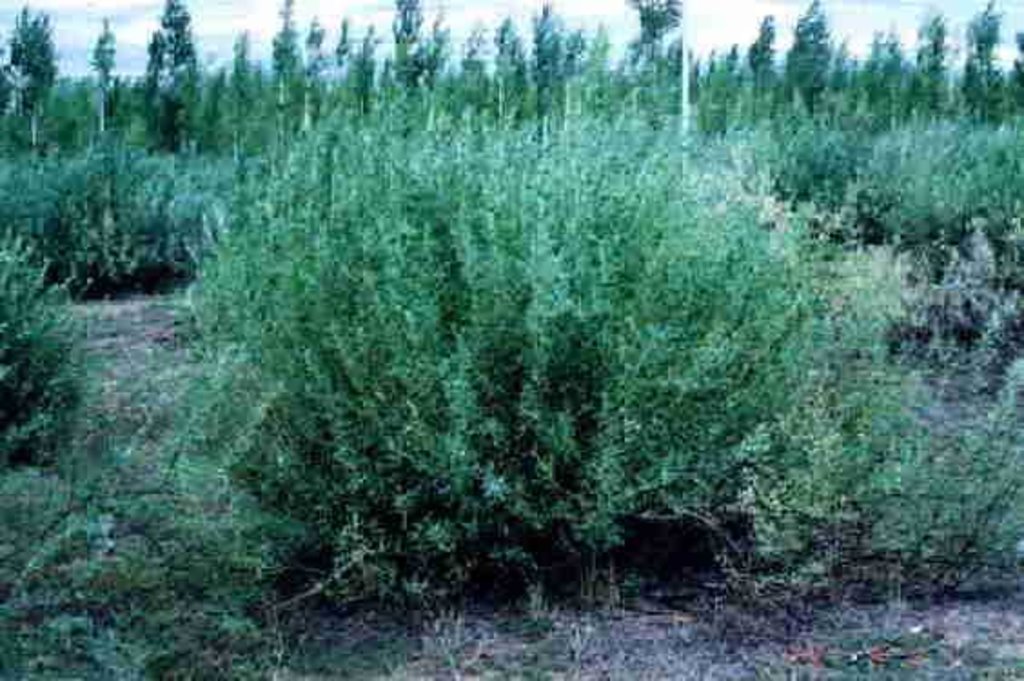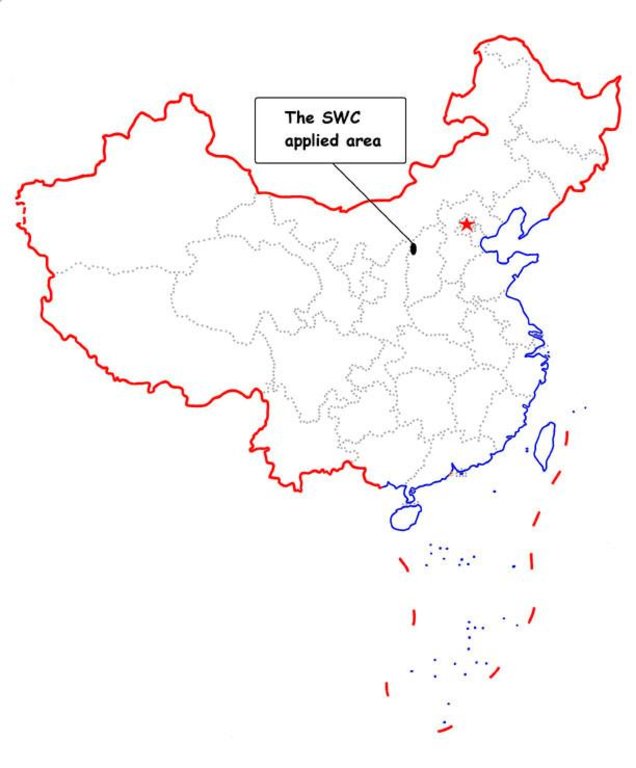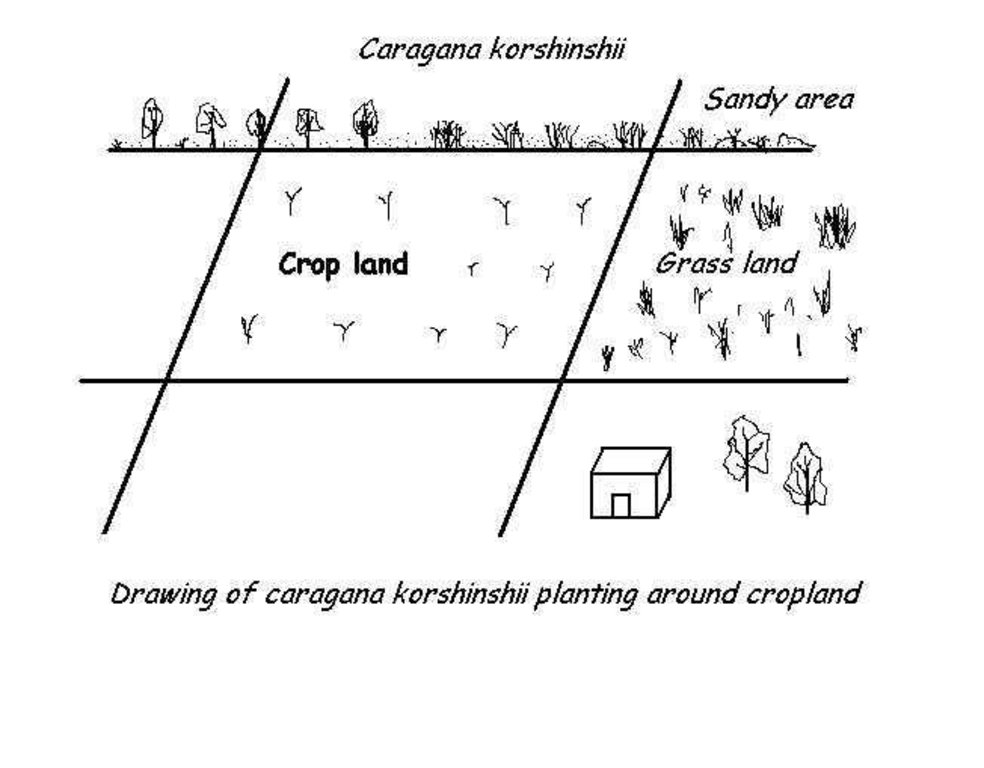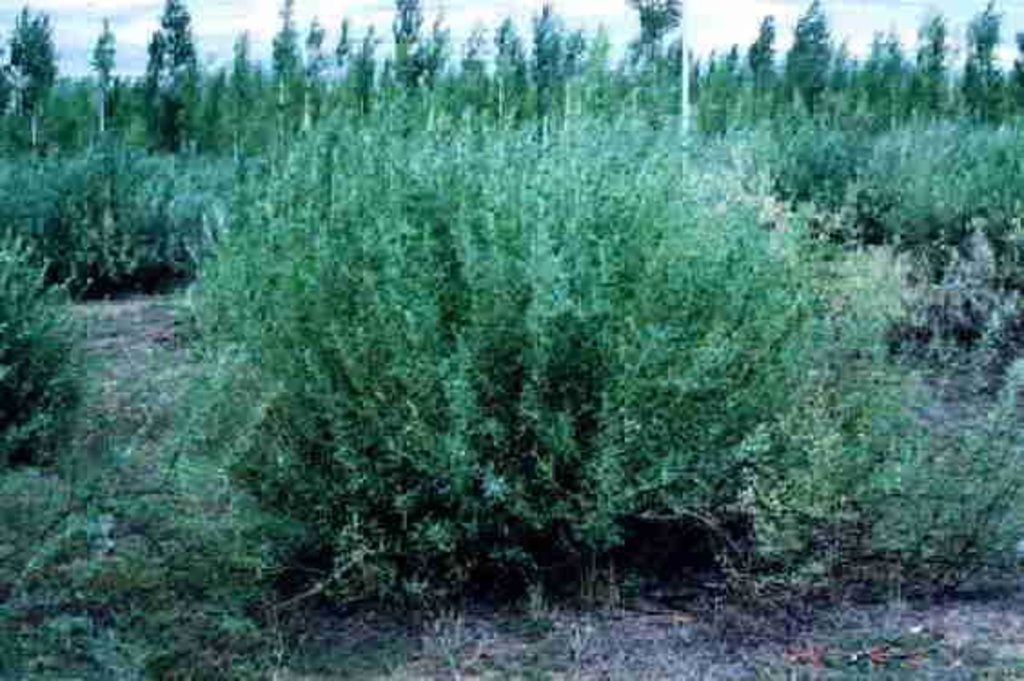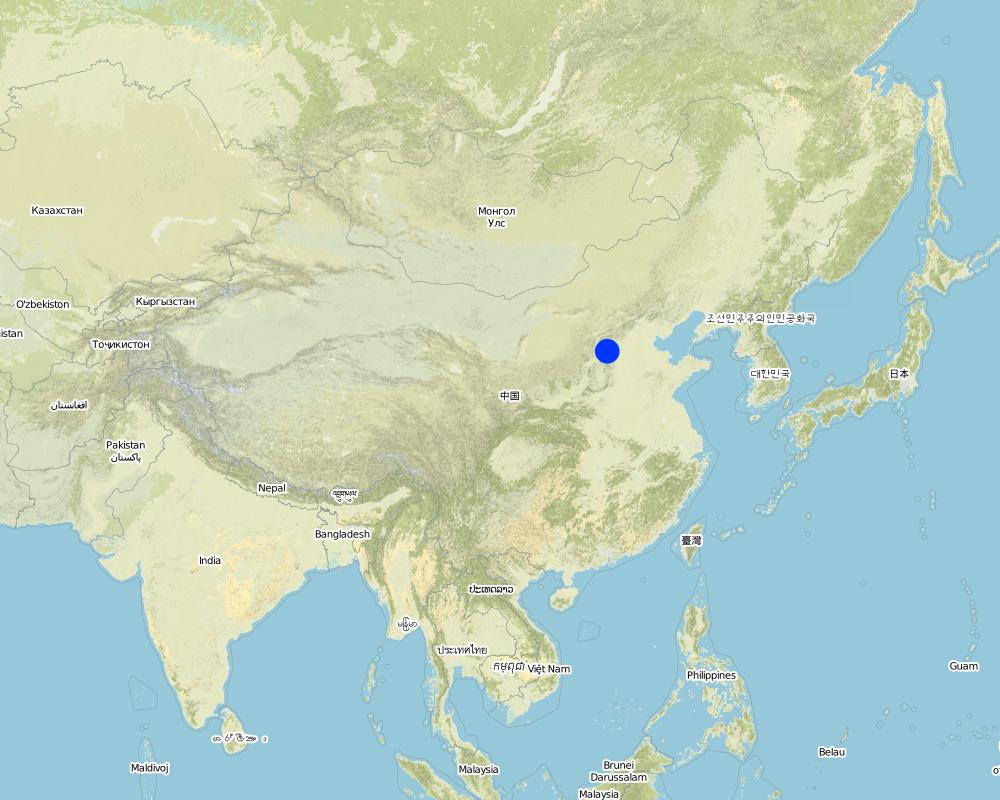Caragana Korshinskii Planting - a SWC vegetation technology [China]
- Creation:
- Update:
- Compiler: Jinsheng FU
- Editor: –
- Reviewer: David Streiff
approaches_2395 - China
View sections
Expand all Collapse all1. General information
1.2 Contact details of resource persons and institutions involved in the assessment and documentation of the Approach
SLM specialist:
Xie Mingshu
(8610) 62338043
Department of soil and water conservation, Beijing Forestry University
China
Name of the institution(s) which facilitated the documentation/ evaluation of the Approach (if relevant)
Department of Resources and Environmental Science, Beijing Normal University (Department of Resources and Environmental Science, Beijing Normal University) - China1.3 Conditions regarding the use of data documented through WOCAT
The compiler and key resource person(s) accept the conditions regarding the use of data documented through WOCAT:
Yes
1.4 Reference(s) to Questionnaire(s) on SLM Technologies

Caragana Korshinskii Planting a kind of SWC vegetative … [China]
Caragana korshinskii, a kind of perennial shrub, is used to protect soil from water and wind erosion, rhizobium in its root can increase soil fertility.
- Compiler: Jinsheng FU
2. Description of the SLM Approach
2.1 Short description of the Approach
SWC decision makers, I.e. approach planners, lead local people to plant caragana korshinskii in the areas of serious water and/or wind erosion by means of combined inputs from government, locals and social loan etc.
2.2 Detailed description of the Approach
Detailed description of the Approach:
Aims / objectives: The most important factor that hinders agricultural development in the Loess Plateau is soil and water loss. Many measures have been taking to conserve soil and water resources. Here is one of them using caragana korshinskii as one kind of SWC vegetation approach.
Methods: With its long roots, caragana korshinskii can improve soil infiltration and extract water from deep soil layer. It can also protect soil from water and wind erosion because it is tightly fixed in the soil. It has rhizobium in its roots to improve soil fertility. Besides, its branch has economic value. To carry out this approach, planners lead local farmers to plant caragana korshinskii in the areas of the serious water and/or wind erosion. Before planting, dipping selected seeds in brine with 1% concentration, and then moving them in warm water for about 24 hours to make them easier germinating. Caragana korshinskii can be planted in holes. Autumn is the best season for seeding, but if there is much rain in Spring, it is also ok. In the first three years, young plants are very frail. They should be protected from sheep eating and cutting. After four years, the branches of caragana korshinskii above ground can be cut according to their utilization. The more you cut the better they grow.
Role of stakeholders: Besides government leaders, local land users are also the most important participants, they accomplish most of planting and maintaining work. The Research Institute is another key participant, they provide the SWC knowledge and technology.
Other important information: Caragana korshinskii has many other advantages besides ecological benefits. It has many economic values, such as supplying forage for sheep and fuel for local residents, supplying raw material for paper making, supplying green manure and improving soil quality. Finance is mainly from government, partially from loan and local input(labor).
2.3 Photos of the Approach
2.5 Country/ region/ locations where the Approach has been applied
Country:
China
Region/ State/ Province:
Shanxi
Map
×2.6 Dates of initiation and termination of the Approach
Indicate year of initiation:
1960
2.7 Type of Approach
- traditional/ indigenous
2.8 Main aims/ objectives of the Approach
The Approach focused mainly on SLM with other activities (Sheep forage, paper making, fuel, green manure etc.)
Controlling water and/or wind erosion, preventing sand and dust storm.
The SLM Approach addressed the following problems: Water and/or wind erosion, inadequate fodder, poor local agricultural and economic development.
Caragana korshinskii is one of the most drought endurable shrubs. Once planted, caragana korshinskii grows very fast.
2.9 Conditions enabling or hindering implementation of the Technology/ Technologies applied under the Approach
social/ cultural/ religious norms and values
- hindering
People there seldom care about the environment
Treatment through the SLM Approach: Education, propagandizing
availability/ access to financial resources and services
- hindering
There is not enough money
Treatment through the SLM Approach: National subsidy, loan, collecting money from public
legal framework (land tenure, land and water use rights)
- hindering
Lack of corresponding acts
Treatment through the SLM Approach: Enforcing legislation
The existing land ownership, land use rights / water rights hindered a little the approach implementation The state has ownership of the land resources, land users can only lease the land for a period of time, they worry about their land would be transferred to others.
knowledge about SLM, access to technical support
- hindering
inadequate
Treatment through the SLM Approach: Learn from SWC specialists, introduce into new acquainted person
3. Participation and roles of stakeholders involved
3.1 Stakeholders involved in the Approach and their roles
- local land users/ local communities
Working land users were work equally divided between men and women (including all the local land users and government politicians)
Existing groups of land users
- national government (planners, decision-makers)
3.2 Involvement of local land users/ local communities in the different phases of the Approach
| Involvement of local land users/ local communities | Specify who was involved and describe activities | |
|---|---|---|
| initiation/ motivation | interactive | public meetings |
| planning | none | |
| implementation | interactive | casual labour |
| monitoring/ evaluation | self-mobilization | measurements/observations; |
| Research | self-mobilization | measurements/observations; |
3.4 Decision-making on the selection of SLM Technology/ Technologies
Specify who decided on the selection of the Technology/ Technologies to be implemented:
- politicians/ leaders
Explain:
directive (top-down). Leaders are the key participants
Decisions on the method of implementing the SLM Technology were made by by politicians / leaders. consultative. From SWC specialist
4. Technical support, capacity building, and knowledge management
4.1 Capacity building/ training
Was training provided to land users/ other stakeholders?
Yes
Specify who was trained:
- land users
- SWC specialists, extensionists/trainers, planners, politicians/decision makers
Form of training:
- farmer-to-farmer
- demonstration areas
- courses
Subjects covered:
seed, establishment and maintenance of Caragana korshinskii
4.2 Advisory service
Do land users have access to an advisory service?
Yes
Specify whether advisory service is provided:
- on land users' fields
Describe/ comments:
Visiting demonstration areas; Key elements: Quality of the demonstration, Ability of visitors, Ability of hierophants; 1) Advisory service was carried out through: projects own extension structure and agents, government's existing extension system 2) Advisory service was carried out through: projects own extension structure and agents, government's existing extension system; Extension staff: mainly government employees 3) Target groups for extension: land users, technicians/SWC specialists; Activities: farm visits
Advisory service is quite adequate to ensure the continuation of land conservation activities; Activities of government influence the choice of land users greatly, usually by administration ways.
4.3 Institution strengthening (organizational development)
Have institutions been established or strengthened through the Approach?
- yes, moderately
Specify the level(s) at which institutions have been strengthened or established:
- local
Specify type of support:
- financial
4.4 Monitoring and evaluation
Is monitoring and evaluation part of the Approach?
Yes
Comments:
bio-physical aspects were regular monitored by 0 through measurements; indicators: None
technical aspects were ad hoc monitored by 0 through observations; indicators: None
economic / production aspects were regular monitored by 0 through measurements; indicators: None
management of Approach aspects were None monitored by 0 through observations; indicators: None
There were few changes in the Approach as a result of monitoring and evaluation: planting density, frequency of caragana korshinikii branch cutting.
4.5 Research
Was research part of the Approach?
Yes
Specify topics:
- economics / marketing
- ecology
Give further details and indicate who did the research:
comparing Caragana korshinskii with other kind of SWC vegetation species.
Research was carried out on station
5. Financing and external material support
5.1 Annual budget for the SLM component of the Approach
If precise annual budget is not known, indicate range:
- 100,000-1,000,000
Comments (e.g. main sources of funding/ major donors):
Approach costs were met by the following donors: government (national - money, technology, planning): 25.0%; national non-government (money): 45.0%; local community / land user(s) (material, money, labor): 30.0%
5.2 Financial/ material support provided to land users
Did land users receive financial/ material support for implementing the Technology/ Technologies?
Yes
5.3 Subsidies for specific inputs (including labour)
- agricultural
| Specify which inputs were subsidised | To which extent | Specify subsidies |
|---|---|---|
| seeds | ||
| fertilizers | fully financed | |
| seedlings and biocides | partly financed | biocides are fully financed |
If labour by land users was a substantial input, was it:
- paid in cash
Comments:
Labour was also rewarded with sheep breed
5.4 Credit
Was credit provided under the Approach for SLM activities?
Yes
Specify conditions (interest rate, payback, etc.):
Interest rate charged: 0.7%
Interest was lower than market rate.
6. Impact analysis and concluding statements
6.1 Impacts of the Approach
Did the Approach help land users to implement and maintain SLM Technologies?
- No
- Yes, little
- Yes, moderately
- Yes, greatly
They protect their cropland by applying vegetative measures such as planting caragana koshinskii around the land so that both increasing crop yield and additional income by feeding more sheep etc.
Did the Approach improve issues of land tenure/ user rights that hindered implementation of SLM Technologies?
- No
- Yes, little
- Yes, moderately
- Yes, greatly
The approach could very little on it. The problem is likely to be overcome in the near future. By signing land use contract with land ownership.
Did other land users / projects adopt the Approach?
- No
- Yes, little
- Yes, moderately
- Yes, greatly
As one kind of vegetation method, it can be used with other approaches, such as check dam.
6.3 Sustainability of Approach activities
Can the land users sustain what has been implemented through the Approach (without external support)?
- yes
6.4 Strengths/ advantages of the Approach
| Strengths/ advantages/ opportunities in the land user’s view |
|---|
| Obtaining additional economic return (How to sustain/ enhance this strength: Developing Stockbreeding and increasing crop yield.) |
| low input and easy to implementing (How to sustain/ enhance this strength: Forbidding overgrazing and cutting.) |
| Strengths/ advantages/ opportunities in the compiler’s or other key resource person’s view |
|---|
| Reducing wind and water erosion (How to sustain/ enhance this strength: Scientific design and management.) |
| simple SWC and easy to carry out (How to sustain/ enhance this strength: Enhancing training of how to scientifically planting caragana korshinskii.) |
| marked economic benefits that farmers would like to do (How to sustain/ enhance this strength: Further developing the variable uses of caragana korshinskii.) |
| Preventing sand and dust storm in the leeward region. (How to sustain/ enhance this strength: Enlarging planting areas and combining with other SWC measures.) |
6.5 Weaknesses/ disadvantages of the Approach and ways of overcoming them
| Weaknesses/ disadvantages/ risks in the compiler’s or other key resource person’s view | How can they be overcome? |
|---|---|
| no |
7. References and links
7.1 Methods/ sources of information
- field visits, field surveys
7.2 References to available publications
Title, author, year, ISBN:
Yang Wenbin, Ren Jianmin, Jia Cuiping. Studies of The Relationship Between Physiological Ecology of Drought-Resist in Caragana Korshinskii and Soil Water. Acta Ecologica Sinica. 1997,17(3): 239-244.
Available from where? Costs?
Library of Department of Resources and Environment, BNU.
Title, author, year, ISBN:
Hu Xuewen. Marked benefits of developing Caragana korshinskii in Pianguan county. Economic benefits corpus of soil and water conservation. 1987.10: 43-44.
Available from where? Costs?
Library of Department of Resources and Environment, BNU.
Title, author, year, ISBN:
Li Zhirong. To advocate for Caragana korshinskii. Economic benefits corpus of soil and water conservation. 1987.10: 36-38.
Available from where? Costs?
Library of Department of Resources and Environment, BNU.
Title, author, year, ISBN:
Zhao Zhizhong. Planting Caragana korshinskii extensively, breeding livestock to reach richness. Soil and Water Conservation Science and Technology in Shanxi. 1997.3: 26-28.
Available from where? Costs?
Library of Department of Resources and Environment, BNU.
Title, author, year, ISBN:
Niu Xiwu. The distribution and description of Caragana Fabr. In China. Acta Bot. Boreal. Accident Sin. 1999,19(5): 107-133.
Available from where? Costs?
Library of Department of Resources and Environment, BNU.
Title, author, year, ISBN:
Pan Ming, Zhao Jinrong. Benefits of Caragana korshinskii and its planting technology. Economic benefits corpus of soil and water conservation. 1987.10:39-42.
Available from where? Costs?
Library of Department of Resources and Environment, BNU.
Title, author, year, ISBN:
Cheng Jimin. The Reasonable Utilization and Patterns of the Main Shrub Species In Southern Ningxia Hui Autonomous Region. Bulletin of Soil and Water Conservation. 1991,11(1): 54-61.
Available from where? Costs?
Library of Department of Resources and Environment, BNU.
Title, author, year, ISBN:
Li Jinchuan, Wang Wenying, Lu Chongen. Exploration on Restoring Vegetations of Dump Land on An-Tai-Bao Surface Mine. Henan Science. 1999,17(Suppl.): 92-95.
Available from where? Costs?
Library of Department of Resources and Environment, BNU.
Title, author, year, ISBN:
Bai Yongqiang. Studies on Phonological Patterns of the Main Shrubs in Yanchi Sandy Land. Journal of Arid land Resources and Environment. 1998,12(2): 82-86.
Available from where? Costs?
Library of Department of Resources and Environment, BNU.
Links and modules
Expand all Collapse allLinks

Caragana Korshinskii Planting a kind of SWC vegetative … [China]
Caragana korshinskii, a kind of perennial shrub, is used to protect soil from water and wind erosion, rhizobium in its root can increase soil fertility.
- Compiler: Jinsheng FU
Modules
No modules


